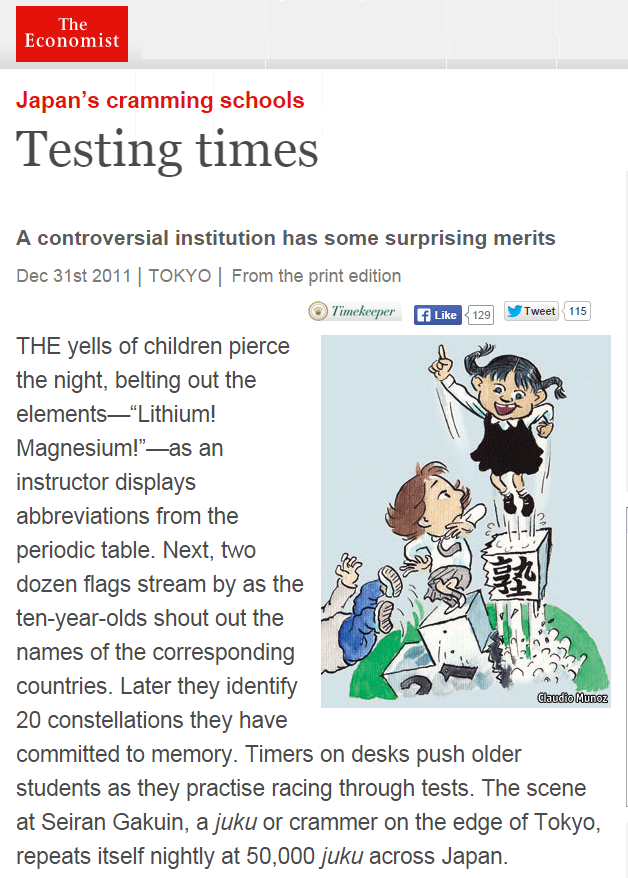Copying from Educational Systems Abroad
"A little bit of knowledge is a dangerous thing." That is why scientific work requires identification and control of every variable that may affect the outcomes being measured or observed. Establishing causation requires much more than just discovering a correlation. Ignoring these rules can easily lead to conclusions being drawn without the proper basis. It is very tempting to find a "smoking gun" that explains what is sought. The intentions are often good, to copy what seems to be working. Not covering all bases, however, only leads to failure especially when important points are missed. Some countries are doing much better in international exams on mathematics so it is only reasonable to look at these countries, learn from them, and transfer the good things about their system to ours. An example of such thinking is illustrated by a piece published several months ago in the New York Times. It is an article by Elizabeth Green, "Why Do Americans Stink at Math?". The following is an excerpt:
The scope of shadow education in Asian countries is vast, capturing the majority of all students. The statistics above must give pause to anyone claiming that the success in schools in these countries may be emulated by simply copying their curriculum and pedagogy. That would not be accurate at all if shadow education, which is significant, is ignored. Ignoring shadow education means dismissing rote approaches to learning. That would be a huge mistake....
"...Instead of having students memorize and then practice endless lists of equations — which Takahashi remembered from his own days in school — Matsuyama taught his college students to encourage passionate discussions among children so they would come to uncover math’s procedures, properties and proofs for themselves. One day, for example, the young students would derive the formula for finding the area of a rectangle; the next, they would use what they learned to do the same for parallelograms. Taught this new way, math itself seemed transformed. It was not dull misery but challenging, stimulating and even fun...."Green basically attributes the success of Japanese schools in teaching math on a constructivist pedagogy and then suggests that the reason why American schools are not successful is the lack of training of teachers on how to implement effectively these lessons. Tom Loveless has an article in Brookings that debunk Green's assertion. Loveless writes:
"The July 27, 2014 edition of the New York Times Sunday Magazine featured an article by Elizabeth Green entitled “Why Do Americans Stink at Math?” In this blog post, I identify six myths promulgated in that article. Let me be clear at the outset. I am an admirer of Elizabeth Green’s journalism and am sympathetic to the idea that improving teaching would raise American math achievement. But this article is completely off base. Its most glaring mistake is giving the impression that a particular approach to mathematics instruction—referred to over the past half-century as “progressive,” “constructivist,” “discovery,” or “inquiry-based”—is the answer to improving mathematics learning in the U.S. That belief is not supported by evidence...."One evidence that Loveless cites is the following:
Teachers’ Reports on How Often They Ask Students to Do Reasoning Tasks
Never or Almost Never
|
Some Lessons
|
Most Lessons
|
Every Lesson
| |
Japan
|
0%
|
7% (594)
|
55% (604)
|
37% (608)
|
U.S.
|
0%
|
24% (495)
|
50% (498)
|
26% (514)
|
Source: Table 5.11, IEA Third International Mathematics and Science Study (TIMSS), 1994-1995, page 160.
The above clearly shows that the difference between American and Japanese students of about 100 points is maintained across the board. It does not matter whether a student receives a “progressive,” “constructivist,” “discovery,” or “inquiry-based” instruction. And among Japanese students, having more lessons that require reasoning tasks leads to only small differences. Another point that Loveless raises is the shadow education in Japan called juku. The Economist had an article on juku several years ago:
 |
| Above copied from The Economist |
These "cramming schools" in Japan, as Loveless is suggesting, may be a significant factor behind the difference between the performance of Japanese and American students:
"...An alternative hypothesis to Green’s story is this: perhaps because of jukus Japanese teachers can take their students’ fluency with mathematical procedures for granted and focus lessons on problem solving and conceptual understanding. American teachers, on the other hand, must teach procedural fluency or it is not taught at all...."Shadow education is very pervasive especially in Asian countries that have done well recently in international exams, as illustrated in a study published recently in the Journal of International and Comparative Education:
The scope of shadow education in Asian countries is vast, capturing the majority of all students. The statistics above must give pause to anyone claiming that the success in schools in these countries may be emulated by simply copying their curriculum and pedagogy. That would not be accurate at all if shadow education, which is significant, is ignored. Ignoring shadow education means dismissing rote approaches to learning. That would be a huge mistake....

Comments
Post a Comment